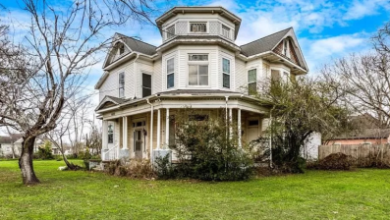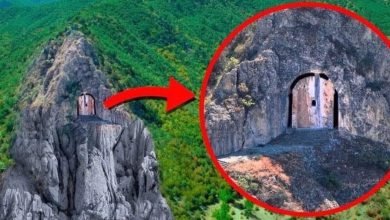The Creepy Past Surrounding Florida’s Dr. Horace Drew Mansion

Nestled within Jacksonville, Florida’s picturesque Springfield neighborhood, the Dr. Horace Drew Mansion stands proudly at 245 West 3rd Street, commanding views of Klutho Park. Constructed in 1909 by the esteemed physician Dr. Horace R. Drew, grandson of Jacksonville pioneer Columbus Drew, this residence is a testament to architectural eclecticism of the early 20th century.
The Horace R. Drew Mansion seamlessly blends various design styles, including Tudor Revival, Queen Anne, and Spanish Colonial Revival. Notably, the house showcases a striking juxtaposition of materials, with the majority crafted from smooth concrete blocks, while the front hexagonal porch boasts elegant Ashlar stone construction.
Adding to its charm are distinctive features such as the third-story porch, offering panoramic views, and the rear second-story “crying porch,” ingeniously designed to provide respite for a mother soothing a restless infant without disturbing her spouse. Notably, Dr. Horace Drew transformed the third-floor attic into a billiards room during the early 1900s, where he engaged in spirited games with none other than actor Oliver Hardy during Jacksonville’s silent film era.
Oliver Hardy, who relocated to Jacksonville in 1913, balanced his career between performing as a cabaret and vaudeville singer at night and working at the Lubin Manufacturing Company by day. The architectural marvel that is the Drew Mansion was envisioned by Leroy Sheftall, in collaboration with Earl Mark, who also lent their talents to design the iconic Moulton & Kyle Funeral Home on East Beaver Street. 
Dr. Horace Drew, along with his siblings, was at the helm of the prosperous H. & W.B. Drew Company, a printing enterprise nestled on West Bay Street in downtown Jacksonville. Specializing in providing businesses nationwide with meticulously engraved office stationery, the company thrived under Dr. Drew’s leadership until his demise in 1926. Throughout the 20th century, this printing legacy remained firmly entrenched within the Drew family, eventually earning the esteemed accolade of being hailed as the “oldest family business” in Jacksonville.
However, the company underwent a transformative phase in 1997 when it was acquired by Wells Legal Supply Inc., leading to the establishment of the Wells & Drew Companies. Dr. Horace Rainsford Drew bid farewell to this world on May 28, 1951, leaving behind a profound legacy of entrepreneurial excellence. Following his passing, the Drew family residence found new occupants in the Mears family, who called it home until the 1960s, further enriching the storied history of this distinguished abode.
Between 1967 and 1973, the grand three-story stone masonry home lay abandoned, earning a notorious reputation as the local “haunted house.” In March 1970, under the eerie cloak of darkness, eleven students from Ribault High School in Jacksonville dared to explore the dilapidated mansion around 11 PM, unwittingly on the fateful night of Friday the 13th.
Their adventure took a chilling turn when two African American teens forcefully entered the premises, one brandishing a knife and the other wielding a sawed-off shotgun, their motives clear: to acquire illicit substances from the unsuspecting group. Despite the students’ denials, the intruders resorted to robbery, compelling them to surrender their money by passing around a hat.
The situation escalated as the assailants singled out two girls from the group, separating them from the others and leading them to another abandoned house. There, they endured horrifying sexual assaults after their clothing was forcibly removed. Following their harrowing ordeal, the traumatized girls were eventually released, while the perpetrators returned to the Drew mansion, leaving behind a wake of fear and despair.
Several months later, on a serene Saturday afternoon in July 1970, two children stumbled upon a chilling discovery in the backyard of the deserted home: a black plastic bag concealing a human head. Shocked and terrified, they swiftly sought help from two teenagers on the street, who promptly alerted the authorities. The head, nestled in an 18-inch hole, had seemingly been unearthed by overnight rainfall, revealing its ghastly presence to the unsuspecting youngsters. The grisly find swiftly captured the attention of newspapers statewide, sending shockwaves throughout Florida.
Investigations revealed that the severed head had been pilfered from a cadaver at Duval Medical Center in November 1969. An informant disclosed to authorities that an orderly at the hospital had clandestinely absconded with the head, interring it in the backyard while occasionally showcasing it to acquaintances. Remarkably, the head, belonging to a man in his 50s, had been preserved within an airtight germicidal bag, staving off decomposition.
On July 12, 1970, the long arm of the law reached out to 18-year-old Michael Tiliakus, who was apprehended upon his arrival at the medical center for his hospital shift. He faced charges of dealing in dead bodies, a misdemeanor offense in Florida. In a bizarre turn of events, it emerged that Tiliakus harbored a peculiar connection to the deceased, who had willingly bequeathed his body for medical education purposes. Consumed by a desire to retain a part of his departed friend, Tiliakus confessed to sleeping alongside the head before ultimately burying it in the Drew mansion’s backyard, driven by fear of repercussions.

During the 1970s, ownership of the property transitioned to the Massey family, who embarked on extensive renovations and resided in the house until 2006. Notably, the Horace Drew Mansion earned recognition as a contributing property to the historic Springfield neighborhood when it was added to the National Register of Historic Places in the 1980s.
However, facing financial challenges, Margaret Massey was compelled to part with most of her belongings through an estate sale and ultimately abandoned the property. According to some longtime residents, Massey spent her remaining years in a nursing home. Subsequently, in 2011, City Code Enforcement initiated citations against the property, primarily due to an overgrown yard and other violations, imposing daily fines amounting to $250.00. Over time, these fines accumulated to a staggering $450,000.
Compounding the property’s woes, recurring flooding from nearby Hogans Creek precipitated the gradual sinking of the home’s foundation, resulting in substantial structural deterioration, with floors slanting several inches. In response to these challenges, the Jacksonville Historical Society designated the Drew Mansion as one of the most endangered historic structures in 2012. Subsequently, in July 2013, the property fell into foreclosure, with Deutsche Bank assuming ownership.
Concerned neighbors rallied to safeguard the property after vandals vandalized it, pilfering copper wiring and damaging windows. In an effort to stem the tide of decay, local historical society members secured the home, although years of neglect had taken their toll, particularly evident in the dilapidated roof.
In a glimmer of hope for the mansion’s restoration, Michael Bourre, owner of Bourre Construction Group and former president of the Northeast Florida Builders Association, stepped forward in February 2015, purchasing the property for $40,000. Bourre unveiled ambitious plans for an $800,000 renovation project, envisioning the historic mansion as a model to showcase the charm and heritage of the Springfield neighborhood.
As months stretched into years, residents of Springfield watched with growing frustration as little to no progress was made on the restoration of the Drew Mansion. Speculation swirled among the community, with many suspecting that the lack of action was deliberate, raising concerns that the property might eventually fall into the hands of GNP Development Partners LLC, which had plans for a mixed-use development on the same block.
In response to mounting concerns, a grassroots campaign emerged, urging Michael Bourre to either initiate construction efforts or sell the house to someone willing to undertake the restoration. Finally, in 2018, the property changed hands, and restoration work commenced, with significant efforts focused on gutting the interior and replacing the deteriorating roof.
However, the onset of the COVID-19 pandemic in 2020 brought restoration efforts to an abrupt halt. Since then, progress has stalled, leaving the Drew Mansion in a state of limbo, much to the dismay of Springfield residents longing to see the historic landmark restored to its former glory.













